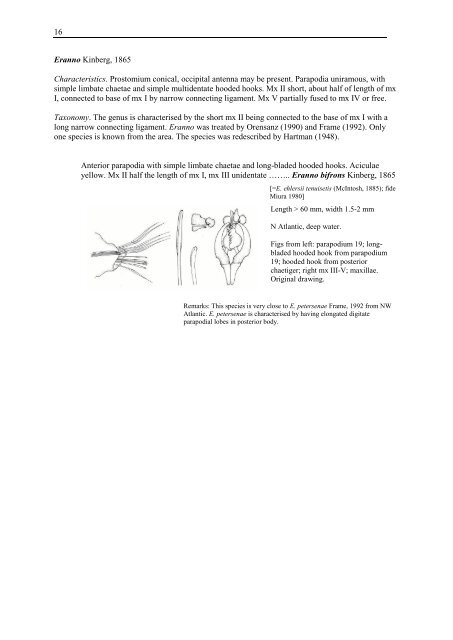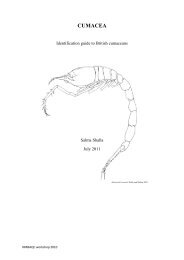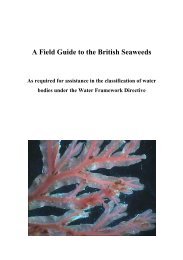Guide to identification of Lumbrineridae - NMBAQC
Guide to identification of Lumbrineridae - NMBAQC
Guide to identification of Lumbrineridae - NMBAQC
You also want an ePaper? Increase the reach of your titles
YUMPU automatically turns print PDFs into web optimized ePapers that Google loves.
16<br />
Eranno Kinberg, 1865<br />
Characteristics. Pros<strong>to</strong>mium conical, occipital antenna may be present. Parapodia uniramous, with<br />
simple limbate chaetae and simple multidentate hooded hooks. Mx II short, about half <strong>of</strong> length <strong>of</strong> mx<br />
I, connected <strong>to</strong> base <strong>of</strong> mx I by narrow connecting ligament. Mx V partially fused <strong>to</strong> mx IV or free.<br />
Taxonomy. The genus is characterised by the short mx II being connected <strong>to</strong> the base <strong>of</strong> mx I with a<br />
long narrow connecting ligament. Eranno was treated by Orensanz (1990) and Frame (1992). Only<br />
one species is known from the area. The species was redescribed by Hartman (1948).<br />
Anterior parapodia with simple limbate chaetae and long-bladed hooded hooks. Aciculae<br />
yellow. Mx II half the length <strong>of</strong> mx I, mx III unidentate …….. Eranno bifrons Kinberg, 1865<br />
[=E. ehlersii tenuisetis (McIn<strong>to</strong>sh, 1885); fide<br />
Miura 1980]<br />
Length > 60 mm, width 1.5-2 mm<br />
N Atlantic, deep water.<br />
Figs from left: parapodium 19; longbladed<br />
hooded hook from parapodium<br />
19; hooded hook from posterior<br />
chaetiger; right mx III-V; maxillae.<br />
Original drawing.<br />
Remarks: This species is very close <strong>to</strong> E. petersenae Frame, 1992 from NW<br />
Atlantic. E. petersenae is characterised by having elongated digitate<br />
parapodial lobes in posterior body.




